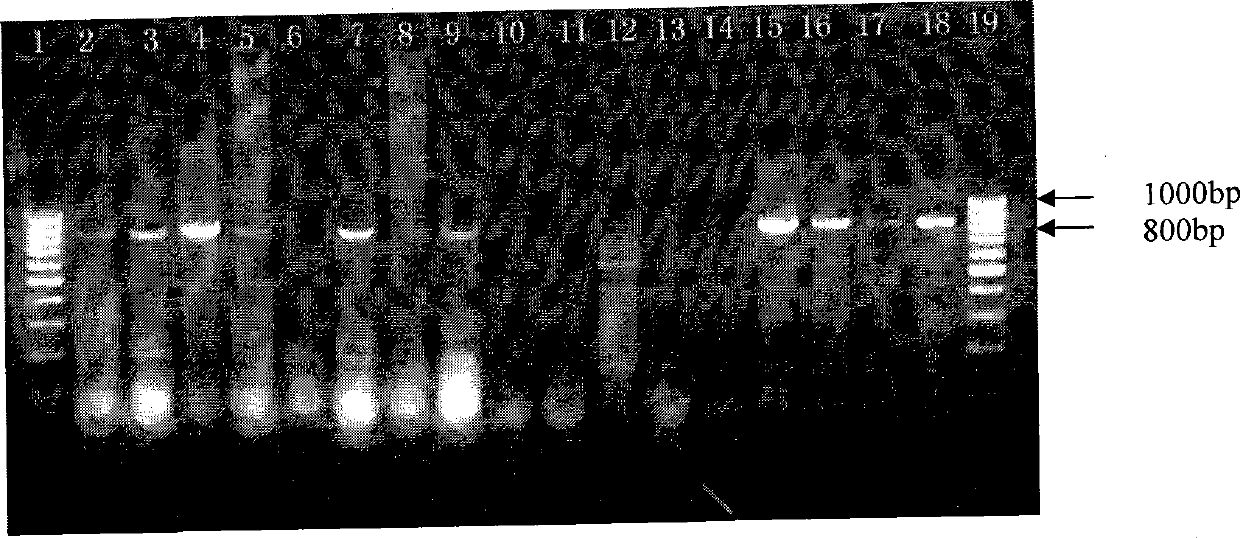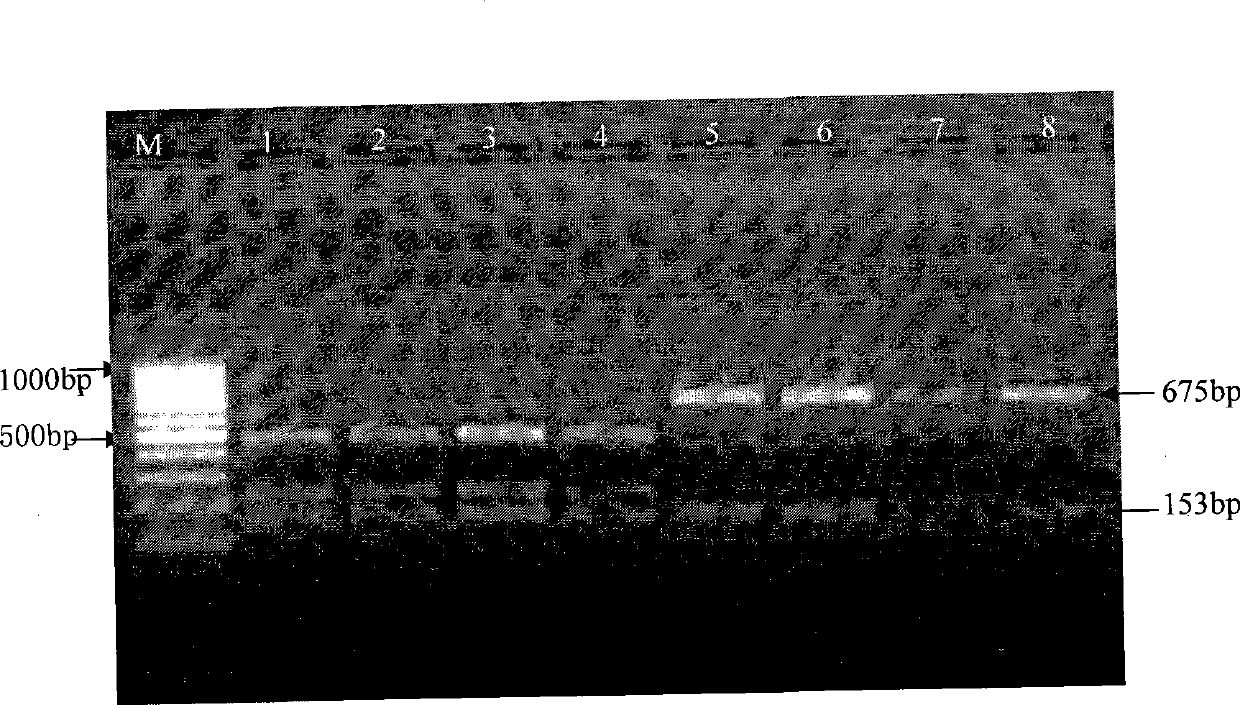A segment of sequence and a restriction enzyme site for differentiating canine distemper viral vaccine strain and wild strain
A technology of canine distemper virus and enzyme cutting site, applied in the direction of microbial measurement/testing, biochemical equipment and methods, etc., can solve the problems of no treatment and comprehensive prevention and control, difficult to determine, etc., achieve high accuracy and efficiency, The effect of the simple identification method
- Summary
- Abstract
- Description
- Claims
- Application Information
AI Technical Summary
Problems solved by technology
Method used
Image
Examples
Embodiment 1
[0010] 1. Design and synthesis of primers:
[0011] A pair of primers P1: 5'TTCTG AGGCA GATGA GTTCT TC3', P2: 5'CTTGGATGCT ATTTC TGACA CT 3' were designed and synthesized, and the target fragment size to be amplified is expected to be 829bp. The fragment of CDV NP gene 829 in the vaccine strain CDV3 strain of the Specialty Research Institute was amplified.
[0012] 2. Viral RNA preparation RNA was extracted using Trizol reagent from Invitrogen Company. The main steps are: (1) aseptically take the viscera or blood of the diseased animal, and add 1:1 PBS to the viscera for grinding; (2) take 250 μl of the grinding suspension, add 750 μl Trizol and 200 μl chloroform successively, shake vigorously for 15 seconds, Centrifuge at 14000rpm at 4°C for 15min. (3) Take out the supernatant and transfer it to a new centrifuge tube, add an equal volume of isopropanol, mix evenly by inversion, settle at room temperature for 10 minutes, and centrifuge at 14000 rpm at 4°C for 10 minutes. (4...
Embodiment 2
[0021] 1. Design and synthesis of primers:
[0022] A pair of primers P1: 5'TTCTG AGGCA GATGA GTTCT TC 3', P2: 5'CTTGGATGCT ATTTC TGACA CT 3' were designed and synthesized, and the expected amplified target fragment size is 829bp. The 829 fragment of CDV NP gene in the Ondersterpoort strain from the joint seedlings of the French Vic company was amplified.
[0023]2. Viral RNA preparation RNA was extracted using Trizol reagent from Invitrogen Company. The main steps are: (1) Aseptically take the viscera or blood of the diseased animal, and add 1:1 PBS to the viscera for grinding; (2) Take 250 μl of grinding suspension and add 750 μl Trizol and 200 μl chloroform successively, shake vigorously for 15 seconds, Centrifuge at 14000rpm at 4°C for 15min. (3) Take out the supernatant and transfer it to a new centrifuge tube, add an equal volume of isopropanol, mix evenly by inversion, settle at room temperature for 10 minutes, and centrifuge at 14000 rpm at 4°C for 10 minutes. (4) P...
Embodiment 3
[0033] 1. Design and synthesis of primers:
[0034] A pair of primers P1: 5'TTCTG AGGCA GATGA GTTCT TC 3', P2: 5'CTTGG ATGCTATTTC TGACA CT3' were designed and synthesized, and the expected amplified target fragment size is 829bp. The fragment of CDVNP gene 829 from the Hebei Changli raccoon dog HCL07 strain was amplified.
[0035] 2. Viral RNA preparation RNA was extracted using Trizol reagent from Invitrogen Company. The main steps are: (1) Aseptically take the viscera or blood of the diseased animal, and add 1:1 PBS to the viscera for grinding; (2) Take 250 μl of grinding suspension and add 750 μl Trizol and 200 μl chloroform successively, shake vigorously for 15 seconds, Centrifuge at 14000rpm at 4°C for 15min. (3) Take out the supernatant and transfer it to a new centrifuge tube, add an equal volume of isopropanol, mix evenly by inversion, settle at room temperature for 10 minutes, and centrifuge at 14000 rpm at 4°C for 10 minutes. (4) Pour off the liquid, add 1ml of 75...
PUM
 Login to View More
Login to View More Abstract
Description
Claims
Application Information
 Login to View More
Login to View More - R&D
- Intellectual Property
- Life Sciences
- Materials
- Tech Scout
- Unparalleled Data Quality
- Higher Quality Content
- 60% Fewer Hallucinations
Browse by: Latest US Patents, China's latest patents, Technical Efficacy Thesaurus, Application Domain, Technology Topic, Popular Technical Reports.
© 2025 PatSnap. All rights reserved.Legal|Privacy policy|Modern Slavery Act Transparency Statement|Sitemap|About US| Contact US: help@patsnap.com


